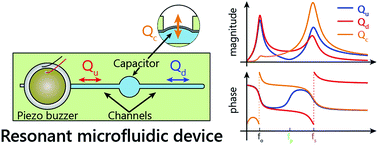Frequency characterization of flow magnitude and phase in resonant microfluidic circuits†
Abstract
The classic electric-hydraulic analogy has been utilized to create microfluidic equivalents of electrical circuits that find applications in lab-on-a-chip and microTAS devices. Despite the continued use of the analogy in pedagogy and for scientific discovery, a thorough experimental validation of this classic analogy using standard electrical characterization techniques has not been performed. In this work, we present two independent methods for assessing the magnitude and phase of harmonic flow in microfluidic networks with deformable features: (1) a custom stroboscopic epifluorescence setup for measuring flow in the channel via bead tracking, and (2) a novel diaphragm-lens optical vibration sensor for estimating flow in the deformable feature. We show that magnitude and phase frequency responses quantitatively match model predictions for series and parallel resonant RLC microfluidic devices. Through this work, we demonstrate the tools and techniques for simultaneous measurement of flow magnitude and phase in microfluidic resonant devices with the goal to further corroborate the electric analogy for two archetypal electrical circuits and to allow quantitative characterization of more complex circuits in the future.



 Please wait while we load your content...
Please wait while we load your content...